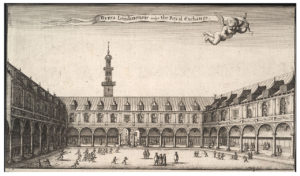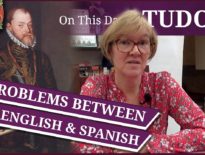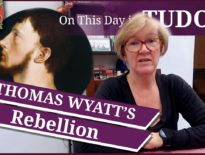On this day in Tudor history, 23rd January 1571, after dining with its founder, Sir Thomas Gresham, Queen Elizabeth I opened the Royal Exchange in London.
Find out more about the official opening, what the Royal Exchange was, why Gresham paid for its building, and what happened to it, in today's talk.
Book recommendation: Gresham's Law by John Guy
Also on this day in Tudor history, on 23rd January 1516, King Ferdinand II of Aragon died. Find out more in last year's video:
Here is an engraving by Wenceslaus Hollar of Gresham's Royal Exchange:
Also on this day in Tudor history:
- 1540 – Birth of Thomas Egerton, 1st Viscount Brackley and Lord Chancellor to James I. Egerton was the illegitimate son of Sir Richard Egerton, a landowner from Cheshire, by a servant girl.
- 1552 – Parliament met to discuss the revision of the 1549 “Book of Common Prayer”.
- 1554 – Baptism of Richard Edes, Dean of Worcester, at Newport on the Isle of Wight. He became Dean of Worcester in June 1597. Edes was also Chaplain and Court Preacher to Elizabeth I and James I.
- 1570 – Assassination of James Stewart, 1st Earl of Moray, illegitimate son of James V and Regent for James VI between 1567 and 1570. He was shot in Linlithgow by assassin James Hamilton of Bothwellhaugh. The hit was ordered by the Hamilton family, supporters of Mary, Queen of Scots.
- 1576 – Death of James Pilkington, Bishop of Durham. He was buried at the church of St Andrew, Bishop Auckland, but then moved later that year to Durham Cathedral.
- 1584 – Death of John Watson, Bishop of Winchester, in Winchester. He was buried in Winchester Cathedral.
- 1600 – Death of John Case, writer and philosopher. He was buried in the chapel of St John's College, Oxford. Case is known for his commentaries on the works of Aristotle.
- 1620 – Death of Sir John Croke, Judge and Speaker of the House of Commons, in Holborn, London. He was buried at Chilton, Buckinghamshire. He was elected as Speaker of the House of Commons in October 1601.
Transcript:
On this day in Tudor history, 23rd January 1571, the Royal Exchange in London was officially opened by Queen Elizabeth I.
Contemporary historian John Stow recorded the opening in his book “A Survey of London” and I’ll share that with you now. He writes of the opening taking place ion 1570, rather than 1571, but that’s because in Tudor times the new calendar year started on Lady Day on 25th March. Here’s what Stow wrote:
“In the yeare 1570, on the 23rd of Januarie, the Queenes Majestie, attended with her Nobilitie, came from her house at the Strand called Sommerset house, and entered the citie by Temple Barre, through Fleetstreete, Cheape, and so by the North side of the Bursse through threeneedle streete (Threadneedle Street), to Sir Thomas Gresham’s in Bishopsgate Streete, where she dined.
After dinner, her Majestie returning through Cornehill, entered the Bursse on the southside, and after that she had viewed every part thereof above the ground, especially the Pawne, which was richly furnished with all sorts of the finest wares in the Citie. She caused the same Bursse by a Herald and a Trumpet, to be proclaimed the Royal Exchange, and so to be called from thenceforth, and not otherwise.”
The queen opened the Royal Exchange after she had dined with its founder, Sir Thomas Gresham at his home. Gresham House in Bishopsgate. AEW Mason, in his 1920 book “The Royal Exchange” cites the French ambassador Monsieur La Motte Fénélon as stating that he sat on the queen’s left hand, while Gresham sat on her right.
John Stow explains that building work on what would be the Royal Exchange had been started on 7th June 1566 when Sir Thomas Gresham, who he describes as “knight, agent to the Queen’s highness”, laid the first stone of the foundation, accompanied by Aldermen who each laid a piece of gold. Stow explains how the building was to be a burse (bourse), a place for merchants to assemble in, i.e. a trading exchange, a centre of commerce. Sir Thomas Gresham was a merchant and financier who had been based at Antwerp in the 1540s. He also worked as Elizabeth I’s agent in the Low Countries. He modelled his exchange in London on the bourse of Antwerp. The City of London Corporation and the Worshipful Company of Mercers provided the land in the ward of Cornhill, and Gresham paid for the building. In his book “Crash Bang Wallop: The Inside Story of London’s Big Bang and a Financial Revolution that Changed the World”, Iain Martin explains that by building the exchange, Gresham was seeking to give something back. Martin writes “His only son had died young and the opening of a bourse gifted to the City was an act of Philanthropy”, although the rents from the shops overlooking the courtyard helped him to recoup some of his expenses.
Mason writes of how the Royal Exchange “became at once the meeting place of merchants and the promenade of men fashion”, that by day it was a place for serious business people to adjust their disputes and engage in transactions with people from all over the world, and then, in the evening, “the butterflies of fashion would flit from Paul’s Walk to the gaily lighted shops of the Pawn”, the Exchange’s shopping centre.
Unfortunately, Gresham’s Royal Exchange was destroyed in 1666 in the Great Fire of London. Samuel Pepys recorded in his diary: “The Exchange a sad sight, nothing standing there, of all the statues or pillars, but Sir Thomas Gresham’s picture in the corner”, i.e. his statue. How sad. The present Royal Exchange is the third exchange to be built on the site and was opened by Queen Victoria in 1844.




Leave a Reply